Thinking Outside the Brace
Español | Español | Translation Sponsored by TCA
By Jason R. Blankenship, PE, SE
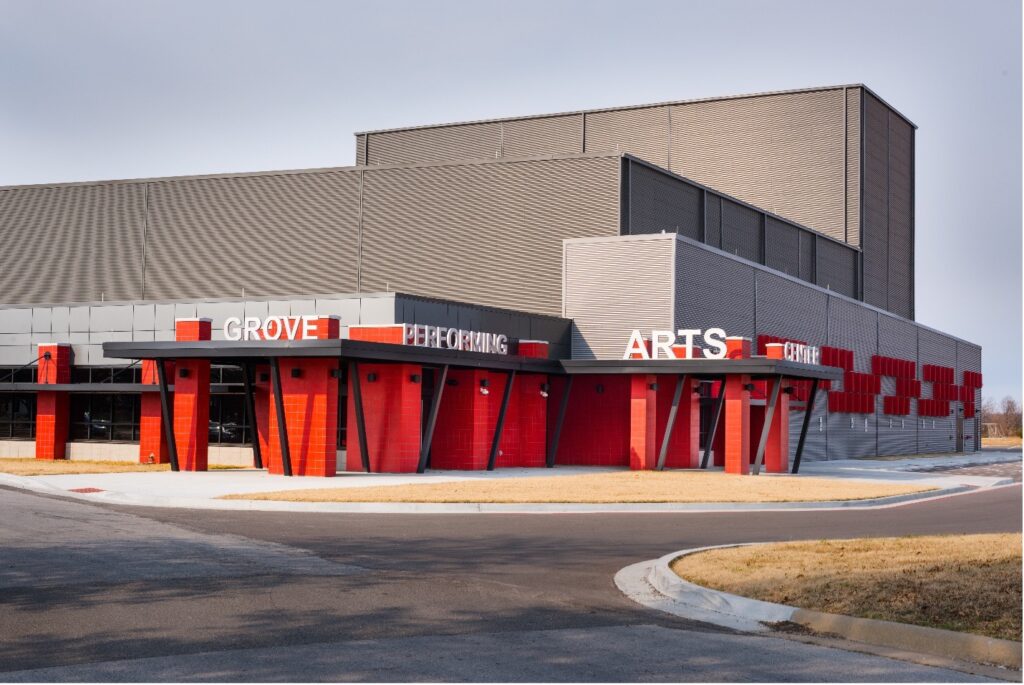
What do you do when you need to brace over 100 tons of concrete panels 70 feet in the air, and the longest standard brace available will only reach up about 45 feet? You design, fabricate, and deliver your own custom bracing system!
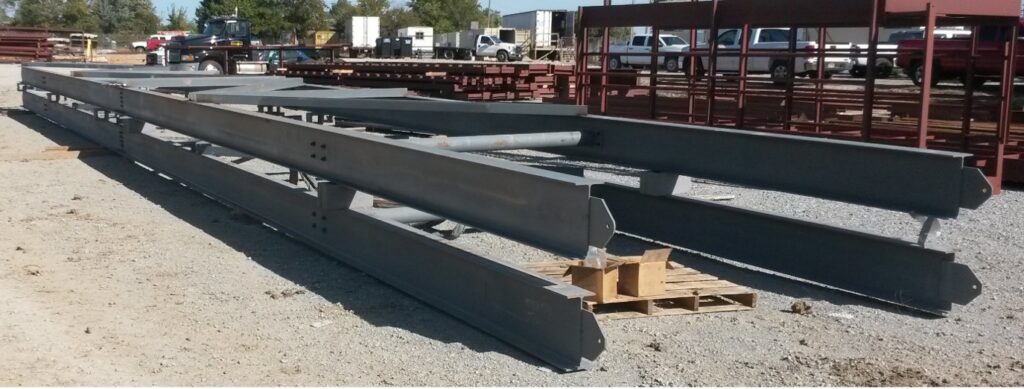
Needham DBS was brought into the project by Crossland Construction Company and Crossland Prefab as part of an overall value engineering effort at the Grove Performing Arts Center in Grove, Oklahoma. Originally designed as load-bearing CMU walls, the project consists of a 1,200 seat auditorium, a 70’ tall stage and flyhouse, and a FEMA storm shelter. A number of limitations made CMU construction a difficult proposition. Erection practicality, schedule, and sequencing were driving factors, leading to a change to “off-site” tilt-up panels (plant-cast panels that are similarly designed to tilt-up). Utilizing a true tilt-up panel design was impossible due to a lack of space on site, so a hybrid approach was employed. Needham DBS was hired to design and detail the wall panels and assist with construction sequencing.
To keep panel weights in check and minimize changes to foundations, the stage panels were designed as ribbed panels (similar to a pan-joist system), using a custom-designed modular insulation form supplied by LiteForm Technologies. The insulation forms were left in place and doubled as attachment for the metal panel façade.
Working within practical fabrication, shipping, and erection limits, Needham DBS leveraged 3D Revit modeling to lay out 160 concrete panels containing over 2,600 embeds coordinated with structural steel, MEP, and architectural models. Accommodation for structural framing, mechanical duct openings, architectural reveals and details—and even special panel lap details for missile protection in the storm shelter—were all performed in 3D for streamlined coordination and detailing. Visualizing the complex details in 3D was critical to coordinating key stability connections with the erection team prior to placement.
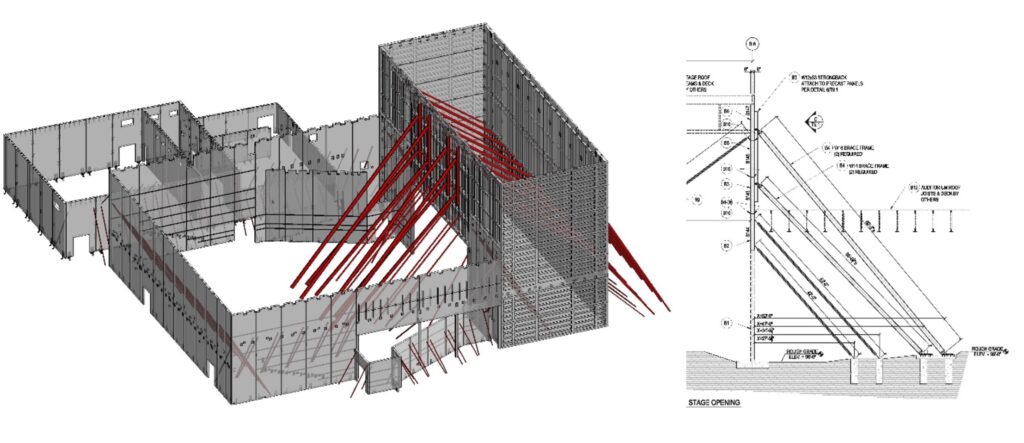
To span the 55’ wide stage opening, a series of four horizontal spandrel panels were cast, using—again—the ribbed insulation system for weight savings. In addition to constraints such as crane capacity and reach, the lack of a floor diaphragm in the center of the flyhouse required considerable thought to devise a pragmatic load path. After studying several options, the final solution was a hybrid, two-way plate design; vertical ribs were stitch-welded together to create vertical continuity, while also leveraging horizontal span capability of the lower panels across the opening. While a horizontal load path was straightforward, it lacked the capacity to handle exterior wind loads above the adjacent roof. Creating the vertical continuity between the stacked panels during erection proved to be the most challenging aspect of the project.
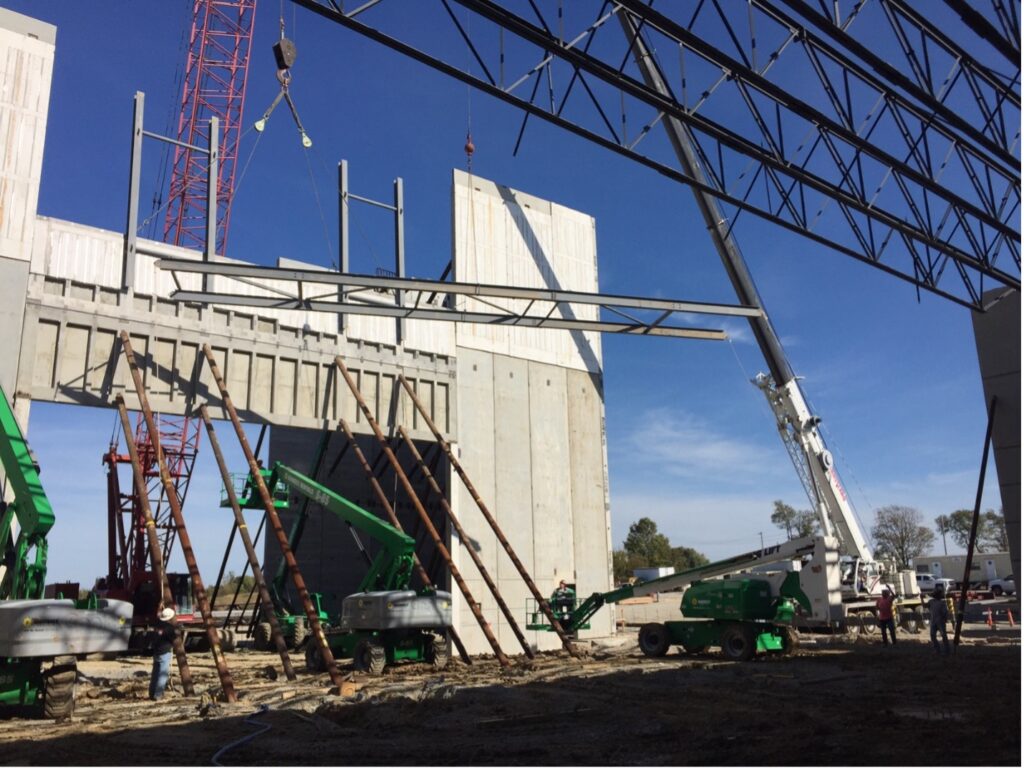
Early communication with the contractor, panel fabricator, and lifting/bracing engineer was crucial to coordinate the erection sequence and bracing scheme to temporarily support the panels until all final welded connections could be installed. The stage spandrel panels required multiple levels of temporary bracing, using both off-the-shelf pipe braces and two levels of custom designed, wide-flange truss bracing. Wide flange strongbacks were bolted to the panels to provide a guide to stack the spandrel panels and offer the lateral support for each spandrel panel that was added. The strongbacks served as the key vertical load path until permanent welded connections, and the flyhouse’s roof framing, could be installed. The longest available rental brace at the time was the Super 52 from Meadow Burke, which was maxed out at the top of the first spandrel. Above this height, custom braces were required.
Needham DBS designed, detailed, and fabricated two pairs of laced steel trusses—65’ long and 82’ long—to be installed as temporary braces. The braces were shipped in two segments with a field splice, lifted in place by a second crane as a complete assembly, and bolted with a simple swivel connection at the top of the brace to allow for connections to be made quickly, and so they could easily be lowered to the foundation for final attachment.
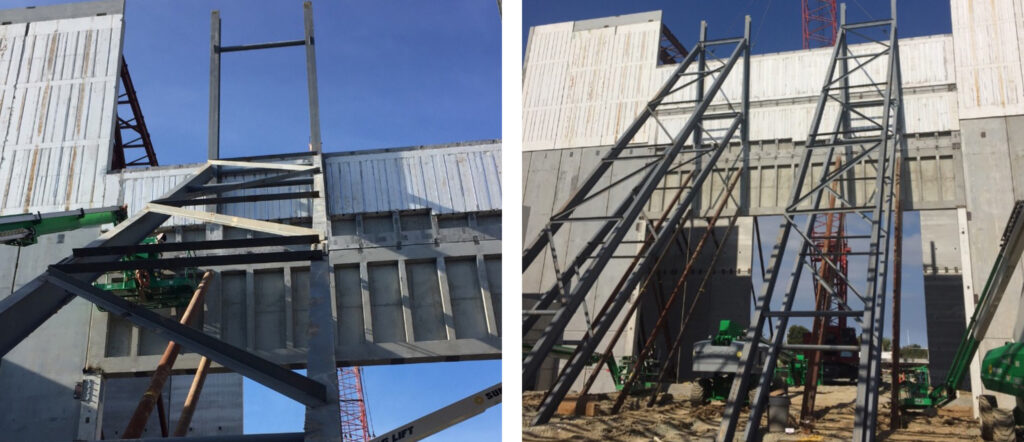
Erection sequencing was critical to distribute the loads correctly. The upper segment of the truss was designed to connect to the vertical steel guides rather than connecting to the panel face, to share loads between multiple panels. Due to the angle and weight of the truss bracing, vertical and horizontal loads from the braces were considered in the design of the vertical columns and panel connections. The erection procedure was carefully orchestrated with an engineer from Needham DBS present on-site.
The lateral forces for the braces required significant foundations. The braces were stacked to allow the base connections to attach to a shared trench footing over 7’ 0” deep x 24” diameter concrete drilled piers. Knowing that erection tolerances would be required for plumbing and alignment, a fixed bracket and a sliding bracket were installed at the base of each truss brace. A heavy-duty ratcheting jack (an off-the-shelf item from farm supply store!) was attached to push and pull the brace as needed. Inspiration for creative solutions can come from anywhere—including, in this case, the top link of a tractor 3-point hitch.
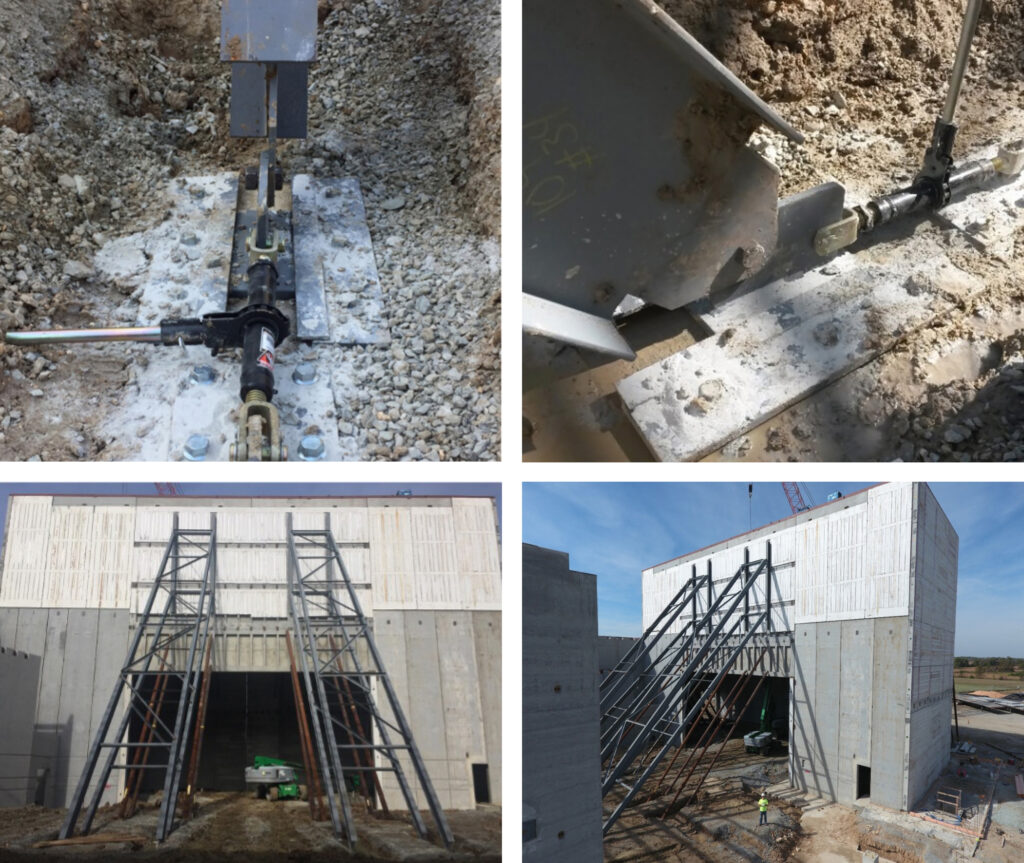
The rear wall of the flyhouse presented other challenges for bracing. Multiple levels of braces were required, but panel sizes were specifically designed to ensure bracing could be accomplished using rental pipe braces. To prevent the front spandrel panels from pushing to the inside, “pass-through” braces were installed crossing through the flyhouse tower, redirecting lateral forces to braces at the exterior wall—a concept similar to the famous flying buttress designs used in Gothic cathedrals. Meadow Burke and Needham DBS worked hand-in-hand to execute this tricky design.
Needham DBS extends special thanks to Crossland Construction for their willingness to explore and execute unconventional solutions, and to Meadow Burke (now Leviat) for their engineering partnership and wealth of knowledge in panel bracing.
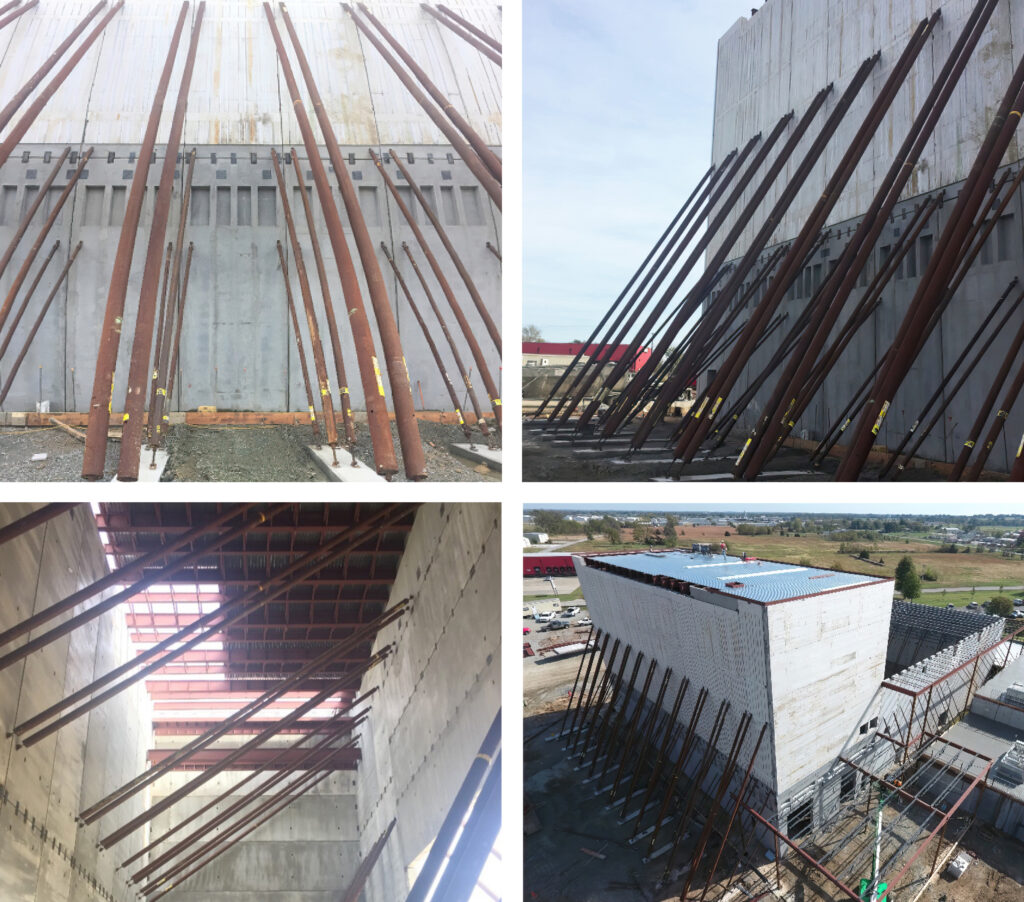
About Needham DBS
Needham DBS is a full-service structural engineering firm and design-build steel supplier, with offices in Lenexa, Kansas, and Fort Wayne, Indiana. Needham DBS is a leader in the tilt-up industry with involvement at many levels within the TCA. A charter member of the TCA, Needham DBS is currently involved in the ACI 551 Tilt-Up Concrete Committee, Composite Panels Task Force, TCA Board of Directors, and a founding donor for TILT Lab.
About the Author
Jason Blankenship, PE, is director of business development at Needham DBS and a licensed structural engineer in 16 states. His focus is primarily on bringing clients holistic building solutions using an engineer-led, design-build, steel procurement approach, frequently in conjunction with innovative tilt-up designs.








